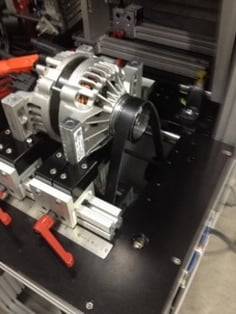+1 (317) 804-2330 | info@ballsystems.com | Blog
+1 (317) 804-2330 | info@ballsystems.com | Blog

When you need a test system designed for your rotating electrics device, the beginning steps of the process are often some of the most critical. Without the right designs, concepts and plans developed early on, the probability of delays or errors later in the process can increase significantly. The test engineers that have the most success with projects like alternator tests, electric motor tests, starter tests, stator tests, and HEV motor tests all stay focused on defining fundamental aspects of the system and of the test plan first. Here are the five steps we recommend completing before work starts with building the system:
How to get started with your rotating electrics test system
1). Understand the mechanical design of the motor or generator – First, the test engineer should conduct the necessary research to master the details and specs of the device. Working with your product engineer, you want to gather all relevant documents and details. This includes gaining access to the device under test’s (DUT) specifications, documentation and design, all the CAD drawings and any other materials that speak to the makeup of the DUT including the casting design, shaft size, max RPM, cooling considerations, integrated intelligence, currents, and voltages. Find out if there are any existing DUT performance curves. Without a deep understanding of the mechanical and electrical designs, it’s hard to execute a successful test.
2). Develop a concept for a fixturing approach – Next, you want to create a conceptual view of what DUT fixturing you need. In this phase, develop an understanding for how you will support the DUT structurally and hold it in the system securely. Before you begin discussions with a test partner, you also want to define how you want to supply torque to the DUT and how you want to electrically load the DUT. You also need to decide how you are going to electrically connect to the DUT. Also mechanically; Is it belt or gear driven? Direct drive? Is it built into the motor or generator?
3). Create your test plan – In the test planning process, your goal is to define what you are try ing to accomplish with the test system. A big part of this consideration is determining the test class your system falls under. Here are the four most common classes of testing we see in rotating electrics:
ing to accomplish with the test system. A big part of this consideration is determining the test class your system falls under. Here are the four most common classes of testing we see in rotating electrics:
a). Parametric performance testing – For customers needing to characterize DUT output power versus input power.
b). Failure analysis testing – For customers needing to characterize a manufacturing-related specification change or a key component failure mode.
c). Durability/stress testing – For customers needing to characterize DUT performance and reliability during an environmental stress event (i.e. an electrical load dump, thermal cycling, vibration, etc.).
d). Accelerated life testing – For customers attempting to characterize DUT life expectancy using thermal cycling to accelerate DUT component wear/failure modes.
Not all test systems will fall neatly into one of these four categories. You may land on a test plan that combines a few of these classes. Your test system may have unique considerations depending on the DUT. But the test engineer should know what goals they are trying to achieve in order to clearly communicate the specific and critical test system requirements to the test partner to ensure the optimum test system design is specified and built.
4). Determine your data collections needs – Finally, you need to know the accuracy and resolution of measured data (e.g. millivolts or microvolts, amps or microamps). Define how often you will sample the data – are you measuring continuously, every one second, every 20 milliseconds, etc.? Identify all the different variables you will attempt to measure concurrently. Determine how much data will be stored, under what conditions it will be stored, and how detailed the logs need to be. These four data considerations will define for you what your data acquisition, accuracy, computing and memory requirements will be.
5). Evaluate potential test partners – At this point, you have properly prepared your team to bring on a test partner to begin developing a system for your product. Use these four considerations above to inform the RFP you send out. Then, meet with potential partners to confirm your test system requirements.
If you’re ready to have this discussion and move your project forward successfully, get in contact with us today.

Ball Systems designs, develops, and delivers custom test systems and produces comprehensive build-to-print systems for companies creating or manufacturing critical electronic or electro-mechanical components for automotive, aerospace and defense and consumer appliance applications.
Blog Comments